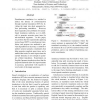Free Online Productivity Tools
i2Speak
i2Symbol
i2OCR
iTex2Img
iWeb2Print
iWeb2Shot
i2Type
iPdf2Split
iPdf2Merge
i2Bopomofo
i2Arabic
i2Style
i2Image
i2PDF
iLatex2Rtf
Sci2ools
ACL
2015
2015
Syntax-based Simultaneous Translation through Prediction of Unseen Syntactic Constituents
Simultaneous translation is a method to reduce the latency of communication through machine translation (MT) by dividing the input into short segments before performing translation. However, short segments pose problems for syntaxbased translation methods, as it is difficult to generate accurate parse trees for sub-sentential segments. In this paper, we perform the first experiments applying syntax-based SMT to simultaneous translation, and propose two methods to prevent degradations in accuracy: a method to predict unseen syntactic constituents that help generate complete parse trees, and a method that waits for more input when the current utterance is not enough to generate a fluent translation. Experiments on English-Japanese translation show that the proposed methods allow for improvements in accuracy, particularly with regards to word order of the target sentences.
| Added | 13 Apr 2016 |
| Updated | 13 Apr 2016 |
| Type | Journal |
| Year | 2015 |
| Where | ACL |
| Authors | Yusuke Oda, Graham Neubig, Sakriani Sakti, Tomoki Toda, Satoshi Nakamura |
Comments (0)

